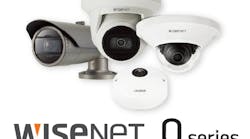It took 18 years, but in 2014 the tipping point finally arrived — for the first time, IP video garnered more than half of the revenue in the video surveillance market. Given the obvious advantages of IP video over older analog technology, many industry pundits wonder why it took so long to reach this pivotal juncture. And more to the point, when can we expect the other half of the market to be converted?
To make any predictions about the rate of adoption, one first needs to understand that different market segments follow their own timetable for embracing IP video. System size seems to be one of the greatest delineators. Enterprise users — those with 100 or more cameras — were the earliest adopters of IP cameras. Mid-size system users — those with 10-100 cameras — have been somewhat slower to make the switch. And significantly lagging behind both are the small system users — those with 1-10 cameras — where DVR-based solutions seem most firmly entrenched.
The Spread of IP video in Enterprise Solutions
Enterprise-sized installations operating 100 or more cameras were the first to grasp the potential benefits of IP video: its sharp HDTV and multi-pixel image clarity; advanced compression standards for more efficient storage and bandwidth consumption; faster frame rates for smoother streaming; and great image usability with a 16:9 aspect ratio to complement widescreen HDTV viewing monitors.
The technology quickly made inroads into large-scale operations like schools, healthcare consortiums, government facilities, transportation centers and casinos because they needed the scalability that analog systems could not provide. Most of these environments already have a robust backbone in place for other data transmission, making IP video a natural fit because it can readily piggyback on the network like any other network device.
Unlike proprietary DVR-based analog solutions, IP video is based on open platform standards. This allows enterprise users to integrate best-of-breed components from multiple vendors to match their surveillance goals and budget — everything from network storage and switches to fiber cable, network cameras, video management software and video analytics. They can even take advantage of low-cost, off-the-shelf components in building their surveillance solutions. And because all the pieces adhere to open standards they can be easily replaced or updated as needed. This ensures that enterprise users can add functionality and performance enhancing components throughout the life of their surveillance system which extends the value of their original investment.
Here are several additional benefits for enterprise users:
- Open systems and standards also provide a framework for tighter integration among physical security systems. Enterprises have come to value the benefit of adding a video context to fire and smoke alarm systems, environmental sensors and even access control solutions to create a more cohesive, all-encompassing security and safety solution.
- Unrestricted scalability has also been a critical factor in tipping the balance in favor of IP video. Unlike DVR-based systems that come in set channel increments, customers choosing IP-based systems have the freedom to add cameras one at a time or in any multiples they want. This enables them to create integrated surveillance networks that are able to incorporate a single camera or as many as 100,000 cameras or more. This limitless scalability can only be possible with network-based technology.
- Remote accessibility has been another welcomed advantage for enterprise users. Being network-based, the cameras and storage can be accessed over the web from any secure device — whether it is a desktop, laptop, smartphone, tablet or other mobile equipment. Or they can use the cloud for video management. This gives security professionals enormous freedom to view live footage and conduct forensic investigations wherever they happen to be. It also means that integrators and service providers can troubleshoot, maintain and upgrade systems remotely, foregoing the expense and wait time for onsite service calls.
- Video analytics are creating cross-department value for surveillance systems. Analytics have transformed video from a purely reactive forensic tool into an instrument for gathering business intelligence. It is now common for many enterprise physical security and loss prevention professionals to share video with marketing, merchandising and operations departments to gain insight into ways to improve the bottom line.
With all these advantages, it is no wonder that a majority of enterprise installations have been IP video users for decades; in fact, today virtually all new enterprise video surveillance installations are IP-based.
IP Video in Mid-Sized and Small-System Solutions
While scalability, improved functionality and better image quality were the driving forces for large-scale IP systems, other factors are influencing the decision of smaller installations to adopt IP video or remain loyal to analog. Foremost has been the longstanding bias of security integrators towards installing more familiar DVR technology. That bias has been waning in recent years — especially with vendors introducing innovations to simplify the installation and operation of network video systems and dropping technology costs to make IP video more affordable for smaller camera-count applications. A few of those innovations include:
- PoE — a single cable does it all: While analog cameras require running two cables to the head-end for each camera, network cameras with Power over Ethernet (PoE) use a single cable connected to the network node to power the camera and transmit the video. It is even possible to run the heater and fan for outdoor cameras and send control commands like pan, tilt or zoom through that same cable — saving a bundle on cabling costs.
- Built-in optics motors — cutting installation time in half: Fine-tuning analog cameras is a laborious process requiring technicians to connect each camera, one at a time, to a specialized focusing monitor; or by using a two-way radio to speak with someone watching a display at the central monitoring station who gives them live feedback as they adjust each lens. With remote focusing capabilities, set-up time with IP video is much faster, which significantly saves labor costs and ultimately lowers the overall cost of ownership for a network surveillance system.
- Ease of use and security: In mid-size and small system installations, users are finding that network video systems are getting easier to manage than analog and far more secure than DVR-based systems because they can leverage standard off-the-shelf IT network security technologies. For small system users with less technical expertise, where simplicity and affordability have been the primary barriers to adoption, network video manufacturers have taken great pains to create solutions that are very intuitive to install, maintain and operate.
- Hosted video — taking the complexity out of surveillance: Mid-sized and small system users can limit their upfront investment by using a service provider to store the recorded video in the cloud and maintain system components remotely. This solves a number of security challenges, such as eliminating the vulnerability of housing recordings on DVRs, where they can be easily tampered with or stolen. It also eliminates the need for in-house technical expertise to manage, troubleshoot, upgrade and service the system. If the hosted video service is integrated with alarm monitoring, users can avoid financial penalties for false alarms, since operators can visually verify an event before calling first responders (police, firefighters, etc.) to the scene.
- Onboard memory cards — removing the cost of onsite storage: Just as smartphones can store video clips, many of today’s network cameras support exceptionally efficient, programmable internal storage. These SD memory cards, which range in capacity from a few GB up to 128GB, eliminate the cost of an onsite server, DVR, NVR or PC to house the recorded video. An SD card can be accessed remotely over the network, eliminating the problem of sufficient bandwidth to stream video to a remote external storage device.
Tapping a Green Field of Opportunity
The result of all these innovations is that mid-size and small systems users are beginning to realize that they, too, can enjoy the same benefits of scalability and high quality video as their enterprise counterparts. And those solutions can be acquired at a price that is well within their budget and well within their limited technical expertise.
As IP video technology continues to evolve, innovations in installation and operability are making it more attractive to broader range of small and mid-sized installations. It is a wonderfully green territory just waiting for savvy security dealers and integrators to tap.
Fredrik Nilsson is general manager for Axis Communications in North America. He is the author of “Intelligent Network Video: Understanding Modern Video Surveillance Systems,” published by CRC Press, and his popular “Eye on Video” article series can be found on SecurityInfoWatch.com. To request more info about Axis, visit www.securityinfowatch.com/10212966.



